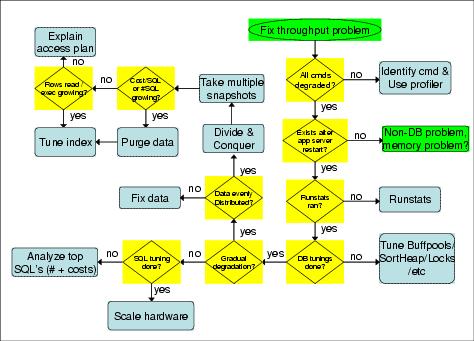Throughput analysis methodology
The main causes of throughput degradation can be...
- code issues
- database issues
- configuration issues
- test data
- method issues
Test reports identify throughput degradation easily. Finding root cause usually requires thorough investigation.
Here we summarize a throughput analysis methodology:
- The methodology does not cover all database problems.
Generally, database problems can refer to any bottleneck due to database, including...
- SQL queries
- database tuning parameters
- indexing issues
- data distribution problems
- Figure 24-19 assumes that a previous performance baseline has been established.
To set a throughput baseline for a test case, and if the scenario has been tested in a previous release or version of the site, we often use its previous result as our baseline. If the scenario is new, we often use the final actual test result in the new release to set up our baseline for future comparison.
- In Figure 24-19, divide and conquer means running with smaller scenarios, such as...
- home page only
- logon only
- browse only
...to isolate the problematic portion of the scenario, rather than investigating the whole end-to-end run.
- Cost/SQL is the execution cost per SQL query. Fetch time is not recorded in execution costs.
- Access plans can change based on accumulated data. You can use DB2 Explain utilities to find more clues.
Figure 24-19 is the recommended scheme for throughput analysis. For a detailed description of each step, refer to the section below, "Throughput degradation analysis and solution.

Figure 24-19 Throughput analysis methodology
| xxxx |